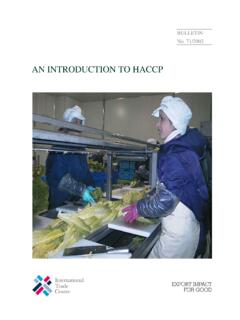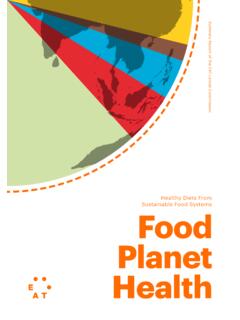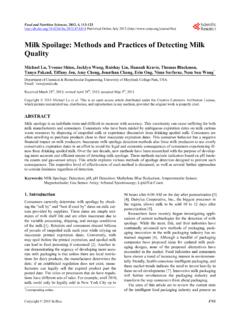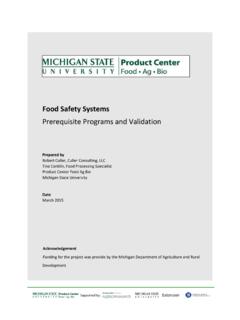Transcription of Milk Processing 1. INTRODUCTION - Uttarakhand
1 milk Processing 1. INTRODUCTION . The Indian dairy industry is contributing significantly to the country's economy, besides improving the health standard by increasing the nutrition value of the food. The value of output from Dairy Sector increased to ,00,510 million in 1994-95 from ,75,080 million in 1990 and is expected to reach the level of Rs. 8,50,000 million by the year 2000 India occupies first position in the world having a total bovine population of 288. million compared to the world's total bovine population of 1420 million. As per 1992. livestock census, the country has about million breedable cows and million breedable buffaloes (Statewise and species/breedwise figures are given in Annexure I). The cross bred cattle are predominant in Kerala, Maharastra, Tamil Nadu , Punjab and Uttar Pradesh, While buffaloes are very common in Uttar Pradesh, Andhra Pradesh, Rajasthan, Madhya Pradesh, Maharastra, Gujarat, Punjab, Bihar, Karnataka , Haryana and Tamil Nadu There has been a major improvement in milk production which increased from 17.
2 Million tones in 1951 to million tonnes in 1997 and the growth was maximum between 1980 and 1990. Uttar Pradesh, Punjab, Madhya Pradesh, Rajasthan, Maharashtra, Gujarat, Andhra Pradesh, Haryana, Tamil Nadu and Bihar contributed to the extent of 85 percent of the total milk production in the country. Today, India is the second largest producer of milk in the world after the United States of America. The present per capita availability of milk is 205 gms as against the ICMR recommendation of 250 gms. The statewise milk production during 1992-93 and targets for 1996-97. along with the per capita availability of milk are given in Annexure I. Recognizing the importance of the sector, the notable programmes taken up are key village schemes, intensive cattle development projects, crossbreeding projects through bilateral assistance, operation flood programme and technology mission by establishing National Dairy Development Board (NDDB).
3 In 1970 under the aegis of NDDB, "Operational Flood" programme was launched to modernize the dairy sector and flood the 4 metro cities with milk from dairy cooperatives. By the end of 1996-97, 74,383 village milk producers cooperatives were organised in 264 districts with an average rural milk procurement of million liters per day. Another step was taken in 1989, to augment rural income by launching Technology Mission on Dairy Development (TMDD), which aims at applying modern technology to improve productivity, reduce costs of operation and thus ensure grater availability of milk and dairy products. With the liberalization of the Indian economy in 1991, the dairy sector too was delicenced. However, on June 9, 1992 GOI issued a milk and milk Products Order (MMPO), according to which, a dairy handling more than 10000 liters of milk per day is required to get itself registered.
4 The registering authority shall be an officer of the State Government or Union Territory in respect of units handling upto 75000 liters/day, or 3750 MT of milk solids per annum, where the entire milkshed of the unit lies within a State / Union Territory. In case of those units, which are handling more than 75000 liters of milk per day or 3750 MT of milk solids per annum, the registering authority is Department of Animal Husbandry and Dairying ,Ministry of Agriculture, Govt. of India. 2. milk PROCUREMENT AND Processing . The organized dairy sector (both cooperatives and private) is presently handling only 10-12 percent of total milk production in the country. The target and achievements of milk production, procurement and Processing in cooperative sector by the end of VIII. Five year plan are given in Annexure II. Thus it indicates, there is a wide scope for Processing of milk and manufacture of milk products for domestic consumption as well as export.
5 3. EXPORT PERFORMANCE. Dairy products form one of the fastest growing segments in the livestock product export. The major products exported are malted milk foods, ghee and cheese (to some extent). to the countries like Bangladesh, UAE, Nepal, Sri Lanka, Bahrain and Oman. The export performance during the years 1980-81 to 1995-96 are given in Annexure III. 4. EXPORT POTENTIAL AND MARKETS. Bangladesh, United Arab Emirates, Nepal, Sri Lanka and Oman are the potential countries for export of malted milk products, butter and ghee. The export of milk and milk products to currently existing markets would increase to million and to new markets to Rs. 155 million. Thus the exports is likely to touch million (APEDA. estimates) by the turn of the century. The GATT agreement further gave a boost to the dairy industry, as India has a comparative cost advantage in regard to milk production.
6 NABARD has been actively involved in credit disbursement in number of schemes in dairy sector. It also encourages development of new products through its research and development funds besides guiding various entrepreneurs in new areas of business and technology. 5. OBJECTIVES OF THE PROJECT. The financial assistance is extended for Processing of milk with the following objectives. i) To enhance the keeping quality of milk and also to avoid economic losses to farmers. ii) For manufacturing various milk products to make it available for the domestic market as well as for export markets. 6. TYPE OF PROJECTS. The type of milk Processing projects that are normally considered for financial assistance are: i) milk Chilling plants: It involves collection of milk from the villages, chilling the milk to 3-4 degree Celsius and transporting to the main dairy for further Processing and manufacture of products.
7 Ii). Market milk Plants: It involves procurement of milk from the villages, chilling, pasteurization, homogenization, packing of milk of various brands (whole, standard, toned and double toned milk ) and supplying them to the consumers. The surplus fat is converted into ghee or table butter or sold as cream to bakeries;. iii). Composite milk Processing Plants : The project involves the collection of milk and Processing into market milk and products like milk powder, cheese, butter, ghee, etc.;. 7. POTENTIAL AREAS: The scope for financing milk Processing activities exists in the entire country. However, it is limited in East and North Eastern parts of the country because of under utilization of existing Processing capacities, low milk production and scatteredness of production base. 8. BENEFICIARIES. The beneficiaries may be individuals, partnership firms, companies, corporate bodies and cooperative societies/unions.
8 9. PROJECT DETAILS. Land and Location: i) Ample space is required for buildings, future expansion, parking of transport vehicles and for empty cans. About two acres of land is required for a milk Processing plant handling about 10000 liters of milk per day (8 hours). However the built up area to total area should be around 1:3 ratio;. ii) The location of a plant should be close to the milk producing area in case of products manufacturing unit and if liquid milk is the main product it should be close to the consumer;. iii) The location of site should have proximity to road/rail facilities, services, such as water, electricity and effluent mains, social infrastructure, etc. iv) The subsoil of the site should be firm with proper drainage. Site Development:- i) Preferably the entire site should be fenced with barbed wire or compound wall is constructed with gates at suitable places.
9 Ii) Internal roads should be of tar/bricks/WBM depending upon the soil conditions, rainfall and the number of vehicles moving every day. Layout and Buildings:- The civil works comprises of factory building, quarters, office, garages, security post etc. The factory building for the milk reception, quality control, Processing , packing and storage of milk products should be as per the BIS. The total covered area depends on the processes involved, products manufactured, the quantity of milk handled and the equipment chosen for services and product manufacturing. About 4000 area of building is required for handling 10000 liters of The essential sections of a milk Processing plant are given in Annexure IV. The layout plans for a plant of 10000 liters per day is given in Figure 1 . Plant and Machinery: The sectionwise equipment required, their specifications, quantity and costs for 10,000.
10 Liters capacity plant are given in Statement 3. The machinery should be as per the BIS. Most of the dairy machinery are manufactured in the country by ALFA-LAVAL, L&T, HMT, Nichrome Pvt. Ltd., Samarpan Fabricators , Goma Engineering Ltd. etc. Technical Collaboration:- Normally the technical collaboration may be for supply of machinery, technical know- how for manufacture or marketing of products. If any such collaboration arrangement is there, name of the firm, country and term of agreement is required to be mentioned. Manufacturing Process:- The operations involved in the manufacturing process should be given in the form of a flow diagram. The flow diagram for a 10,000 litre per day milk Processing plant is furnished in the Annexure V for guidance. Infrastructural Facilities for Raw Material and Utilities Raw Material: The principal raw material is milk . The extent of milk shed area, milch animal population , average milk yield, percentage of animals in milk , marketed surplus ,etc will determine the size of the plant.






